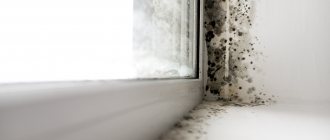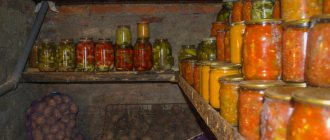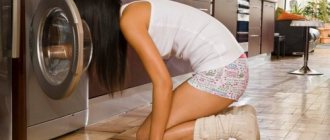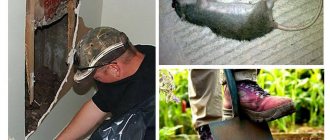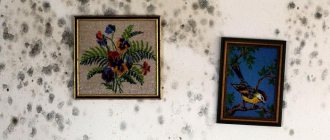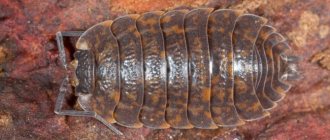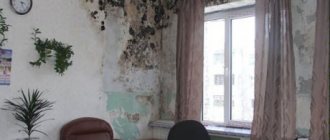- April 1, 2019
- Walls
- Ksenia Yedikhanova
Most people have at least once encountered the problem of black mold on the walls of their home. It consists of small black specks that no one pays attention to and simply erases them. Unfortunately, it soon begins to grow and become larger in size. How to get rid of black mold on the walls of an apartment? Effective methods and nuances are described in the article.
Habitat
Where is black mold most likely to appear? She, like all fungi, needs a nutrient medium. The most suitable conditions for its life are damp places. For example, if there is a problem with leaking pipes in the bathroom, then there is a high probability of dark spots forming on the walls.
In addition, black mold can be found anywhere - in the refrigerator, near ventilation grilles, vents, on bread, fabric, under the sink, bathtub, at the joints of tiles, in places where the shower stall or bathtub touches the walls.
The main condition for the existence of black mold is high humidity. It can feed on both organic and inorganic products, such as glue and wallpaper.
Causes
How to get rid of black mold in an apartment? To do this, you need to eliminate the main causes of its occurrence. As stated earlier, the optimal habitat for mold is high humidity in the home, which, in turn, is provoked by the following reasons:
- poor ventilation;
- dampness in the basement;
- walls that freeze in winter;
- a large number of plants that require frequent spraying;
- constant drying of large amounts of laundry in the living room;
- poor insulation of inter-wall seams and cracks;
- insufficient heating of the home.
Mold can also appear if there are cracks in the house through which moisture enters from the outside and destroys the wall from the inside. If mold gets inside such a crack, getting rid of it can be problematic.
Causes and signs of mold
To get rid of mold once and for all, it is enough to clearly determine the cause of its appearance in your apartment and eliminate it. The fact is that fungal spores are present in any room, but the basis for their development is favorable conditions, which become the reasons for the appearance of moldy spots in different parts of your home :
high humidity combined with poor ventilation, which often happens in the kitchen or bathroom, in apartments on the first floors, houses where humidification is abused, etc.;- freezing of walls;
- ground dampness;
- leaking water pipes;
- roof leaks;
- poorly heated room.
Everyone has probably already encountered the phenomenon of mold and can easily recognize it: it is the appearance of an unpleasant damp smell, spots of black, gray or white. To get rid of mold forever, you need to apply a set of measures, and in addition to the means described below aimed at combating already existing fungus, be sure to eliminate the cause of its appearance.
In general, all work to combat mold in the house comes down to the following list of measures:
- clean the affected surface from mold;
- treat the surface with a mold repellent;
- Throw away all items severely damaged by fungus;
- create normal conditions in the room: good ventilation, normal heating, eliminate all sources of high humidity.
At the moment, a lot of anti-mold remedies have been invented, each of them is applicable in certain conditions and differs in some features.
Types of mold
In order to know how to remove black mold, you need to decide on its type. The general name usually refers to several of the most common types of molds:
- Aspergillus black is a fungus that loves high humidity. This is what appears in the bathroom, kitchen or even in the air conditioner. Most often it attacks the seams between tiles in the bathroom or toilet.
- Aspergillus fuming, the peculiarity of which is that it can easily withstand temperatures up to 53 degrees, and is therefore resistant to high temperatures in the bathroom.
- Alternaria alternata is a black fungus that attacks fabric and food, as well as wood.
These mold spores are equally dangerous to both humans and pets, so if they appear, you should get rid of them as soon as possible.
Method 3 – removal of black mold in mass quantities
- If the surface is deformed or has a strong damp smell, then most likely there will be mold there. This could be under the bathtub or sink. Between plasterboard walls or in doorways. Mold also often appears on the ceiling, as warm air rises to the top.
- If the scale of the affected surface is large and the losses are huge, then it is easier to completely replace the element. Such problem areas may include tiles, carpet, floorboards, and suspended ceilings.
- Before replacing or cleaning, seal all holes and cracks with plastic. This is necessary to prevent disputes from getting into other rooms. Leave only ventilation openings that do not lead into rooms.
- Be sure to wear protection. Goggles, respirator, overalls (or just old clothes that you don’t mind throwing away), gloves.
- Be sure to pack everything you remove and seal it with tape. Wrap affected trim pieces in trash bags. Under no circumstances should black mold spores be allowed to spread.
- If the area is huge, then you will need the help of a professional service.
- It's all about humidity, so in addition to removing mold, you also need to fix the indoor climate. It could be poor ventilation or leaking pipes. Maybe the mold is coming from the basement or attic. You need to examine everything and fix it.
Adviсe
Contact our cleaning company.
Black mold is dangerous, especially for people with allergies or respiratory problems. And so it is the causative agent of such diseases. Monitor your health and as soon as you discover mold, destroy it immediately and ruthlessly.
What is the danger?
At first glance, mold may seem unpleasant but harmless, but this is not the case. Black mold can cause serious harm to humans, including death. If you live near mold fungi for a long time, the following health problems may appear:
- Dermatitis and other skin diseases, the nature of which is difficult to determine, which means they are difficult to treat.
- Diseases of the respiratory system, such as asthma, bronchitis, pneumonia.
- Diseases of the musculoskeletal system, as mold spores negatively affect human joints.
- Allergic reactions up to Quincke's edema.
- Once inside the body, black mold can cause disorders in the functioning of internal organs, especially the stomach and intestines.
When living for a long time in a home with mold, a person becomes irritable, prone to depression, weakness in the body, and frequent headaches. With a high concentration of spores of the fungus of the genus Aspergillus, intoxication of the body can occur.
Elderly people and young children are most vulnerable to mold because their immune systems are not strong enough to fight mold spores on their own.
Types of mold
Let's get straight to the point:
- Type of white mold
Many have seen her and know what she looks like. The soil in which houseplants are planted emits steam due to excess moisture. A white coating appears, which is mold. It is not dangerous for humans unless you have special sensitivity and allergies.
- Type of green mold
This type is observed on food remains that are in a confined space. For example in a container. It is also found on building bricks. Green mold that gets into the stomach causes various types of diseases and poisoning.
- Type of black mold
The most dangerous species. It appears on the walls, ceiling, flooring. Affects different types of surfaces. If you leave it and do nothing, you will have problems sleeping, mold will cause dizziness, asthma, headaches and even increase a person’s temperature. The most dangerous consequences are dermatitis, lung cancer, pneumonia and bronchitis.
- Type of blue mold
This type is noticed on a wooden surface. This could include parquet flooring, picture frames and furniture. It comes out from under the paint layer and looks like a dark bluish coating.
- Type of rotten mold
Also affects wooden surfaces. Her color palette is multifaceted. From gray to brown shades. The wood then cracks and becomes lighter.
No one is immune from mold. Finishing materials do not guarantee that you will never have one. Mold doesn't look good. In addition, it is dangerous to health, so as soon as you see its appearance, start exterminating it.
First signs
Before you remove black mold from walls or other surfaces, you need to find it. Most often, the first spots of mold can be found in the following places:
- on tiles and joints;
- in places where the bathtub comes into contact with the walls;
- in the corners of the room.
First, small spots of a brown or greenish tint appear, which then grow into large colonies of mold fungi. Also, a specific musty smell appears in the room, by which you can unmistakably determine the presence of mold in the house.
Why does mold appear?
The most risky places in the home for mold contamination are bathrooms and kitchens. Here the air humidity often exceeds 60%, and the temperature is 20–25 °C.
Expert opinion
Evgenia Taran
In the bathroom, fungus usually begins to form in the seams in the shower stall, around the bathtub, and windows. Risk areas are any places in the room where there are cold corners. Window sill areas are no exception.
In addition, frequent drying of laundry in the house, cooking food, and watering flowers are also favorable conditions for the appearance of fungus.
Folk remedies
How to eliminate mold on the walls in an apartment? In the event that the fungi have not yet managed to form a large colony and look like individual small spots, folk remedies that have been proven over the years can cope with them:
- Medical ethyl alcohol 96%. Directions for use: Apply a small amount of alcohol to a sponge and wipe the fungus-affected areas. To enhance the positive effect, it can be mixed with ammonia and glycerin; this composition is applied to the affected areas for half an hour and then washed off with water. This method works well for tiled or plastic surfaces.
- Baking soda. Directions for use: a few tablespoons of ordinary baking soda should be dissolved in water, and the resulting solution should be sprayed onto the fungal affected areas. After this, use the hard side of a sponge with a small amount of citric acid to thoroughly rub the areas where fungi have formed.
- On horizontal planes, it is convenient to use the following method: pour a small amount of soda onto the contaminated surface, and then pour 9% table vinegar on top. The reaction that occurs between them will help get rid of mold quickly.
- Copper sulfate. How to get rid of mold in the house on the walls with its help? To do this, you need to dilute 10 g of the substance in 1 liter of water and apply it to the affected surface using a spray bottle.
- For mild damage, you can use tea tree essential oil. It must be mixed with salt, a small amount of water, and then applied in a thin layer to the area affected by the fungus.
Numerous reviews also report that mold can also be removed using hydrogen peroxide, which needs to be sprayed on a colony of harmful fungi.
Ways to get rid of mold
You can fight mold both with special means, which are sold in a sufficient assortment on store shelves, and with folk methods. The latter will be less harmful to the person himself, will cost less, and are not always inferior in effectiveness to their professional counterparts.
Method number 1. Antiseptic primer
This is the most proven method that will definitely help in the fight against fungus. In construction stores, such products are presented in a wide range: Fongifluid Alpa, Dali, Olymp Stop-mold, Biotol-spray, etc. Applying them to an infected surface not only helps get rid of the fungus, but also prevents its occurrence in the future.
Working with such a solution is very simple: it is either sold ready-made or requires the addition of a clearly defined amount of water, as indicated in the instructions. Next, you just need to apply the resulting composition to the required surface, and you’re done.
Important: you need to apply an antiseptic primer only to a well-cleaned surface, so all material affected by the fungus must be carefully removed, and if it has become deeply ingrained, then you will need to clean all layers down to the brick or concrete slab. Then the primer is evenly applied with a regular paint brush onto a dry surface. When the protective layer has dried, you can begin finishing: gluing wallpaper, painting walls, plastering, etc.
Method number 2. Bleach
Bleach is an easier way to get rid of mold in the house, a worthy replacement for professional products. Regular bleach contains sodium hypochlorite (it is also present in many special products as an active ingredient), which has a detrimental effect on mold and its spores, so it is a reliable way to get rid of almost all types of mold. But you can’t use bleach on all surfaces, as they can fade, deteriorate, etc. Bleach is great for glass, tiles, bathtubs, and other non-porous materials, but it won't work on drywall, wood, etc. The fact is that the active substance, chlorine, in this case does not penetrate into the material where the mold particles are located, but acts only on the surface. And the water that is part of such a solution is absorbed by porous materials, leading to even greater mold development.
Working with bleach can hardly be called safe, as it can corrode the skin of your hands and cause poisoning with toxic fumes. Therefore, it can only be used in a well-ventilated area and wearing rubber protective gloves. The solution is prepared from bleach and water in a ratio of 1:10, applied with a brush and wait until completely dry. As in the previous case, the previously damaged surface must be cleaned.
Method No. 3. Vinegar
Regular vinegar, which everyone has in their kitchen, is a weak acid that is poisonous to many types of mold. Its advantage is that it does not emit any dangerous fumes, so it is completely safe to use.
Vinegar is sprayed onto the prepared surface, and then wiped with a dampened rag; after an hour, the surface is washed with water and the room is well ventilated. In particularly damaged areas, it is better to carry out this procedure several times at intervals of one week.
Method number 4. Hydrogen peroxide
Hydrogen peroxide is another poison for most types of mold. You can buy a 3% peroxide solution at any pharmacy; its smell is not so harmful to humans, so working with it is more or less convenient. It should be applied to a prepared surface cleaned of mold, but since peroxide also has a bleaching effect, it is better not to apply it to painted surfaces, but to choose a different method.
Method No. 5. Ammonia
Ammonia works similarly to bleach: it works great on mold on hard, non-porous surfaces, but is not very effective on porous materials. It does its job perfectly when mold has formed, for example, on tiles or glass.
Ammonia must be mixed with water in a 1:1 ratio and sprayed onto the contaminated surface, and after an hour, rinse the solution with water and ventilate the room well. You need to work with ammonia very carefully, as its pungent odor can cause dizziness, headaches, etc. Be careful not to try to use it in combination with bleach, as the reaction between the two will release toxic gases.
Method number 6. Baking soda
Baking soda is one of the easiest and safest ways to get rid of mold, and it does not harm either humans or pets. It is enough to prepare a solution of soda - dissolve a teaspoon in a glass of water - and spray the surface affected by mold with the resulting mixture. You can also wipe moldy things, walls, objects with a sponge soaked in this solution. After an hour, the surface needs to be washed with water, but it is not recommended to completely wash off the soda solution from it: soda is not capable of harming the material, but it perfectly protects against the recurrence of fungus.
Method No. 7. Borax
Borax is a natural material, so it cannot harm human health. It is often used to disinfect toilets and drains, acts as an effective fungicide, insecticide and herbicide, in general, it is an inhibitor of mold growth and a toxin for it.
It is recommended that before starting mold cleaning work, first vacuum the surface with a fine filter, so that during the process as few pores as possible fly in the air and enter the respiratory system. The working solution is prepared as follows: 1 glass of borax is diluted in 2.5 liters of water. The borax solution is applied to the surface with a stiff brush, while simultaneously removing the fungus itself from walls, objects, floors, etc. It is advisable to walk over the surface with such a solution several times; there is no need to wash off anything, since in the future the borax will become a reliable protector against mold.
Method No. 8. Tea tree oil
Tea tree oil is one of the most effective natural remedies that are absolutely harmless to humans. Although this oil is not cheap, you will need very little of it; it has strong antibacterial and antifungal agents.
For one glass of water you will need a teaspoon of tea tree oil. This mixture is added to a spray bottle and applied to the damaged surface, or used to apply it to a sponge; there is no need to wash it off, since this solution will reliably protect against the possible reappearance of fungus.
Tea tree has its own specific smell, but it is harmless and will disappear after a while. By the way, the prepared solution for combating mold can be stored for as long as desired, since it does not lose its strength over time and does not deteriorate.
Method number 9. Grapefruit Seed Extract
This product is similar in action to tea tree oil; it is also expensive, but it is odorless and has a disinfectant and deodorizing effect.
The solution is very simple to prepare: one glass of water requires only 10 drops of grapefruit seed extract. Again, we use a sprayer for application, and after application we do not wash off the solution, since the longer its contact with the damaged surface, the better, and in the future this solution will protect walls and floors from the appearance of new mold stains.
Method No. 10. Potassium permanganate solution
Ordinary potassium permanganate also has a detrimental effect on mold. The damaged surface can be treated with a weak solution of potassium permanganate: add a teaspoon of potassium permanganate to 1 liter of water, and spray or wipe the damaged areas with the resulting composition. The solution does not need to be washed off; it will be effective for some time.
Method No. 11. Lavender and Rosemary Fragrance Oil
These oils contain substances that can counteract the development and activity of mold, so just add a few drops of aromatic oil to a glass of water and then treat the surface: there will be no unpleasant odor of chemicals, these oils are non-toxic for humans, and they perfectly kill most types of mold .
Method No. 12. Stationery glue
Many craftsmen get rid of mold using office glue, which is diluted one to one with water. The method is effective in some cases, but it does not cope with all types of mold, and if the affected area is not very large.
Method No. 13. Iodine solution and camphor balls
An iodine solution and camphor balls will only help if you have just discovered small traces of mold, and you don’t want to use more aggressive means of control yet. Therefore, in an infected room, you can place containers with iodine solution or place camphor balls.
Method No. 14. Lemon acid
To combat fungus, use citric acid or lemon juice, which have the same properties as vinegar - it is a weak organic acid that negatively affects the development of fungus. A teaspoon of citric acid is dissolved in a glass of water, and the surface is treated with the resulting solution. This method is great for tiles.
Method No. 15. Hydrogen peroxide+vinegar+boric acid
All these components are able to cope with mold at the highest level, and together they give an absolutely amazing effect. Water must be mixed with peroxide, vinegar and boric acid in a ratio of 4:2:2:1, and then sprayed or wiped onto the surface.
Method No. 16. Let's get rid of it for sure
Even if you have dealt with the mold that has formed in accordance with all the instructions, there is still no guarantee that it will not appear again. It is important not only to remove the fungus that has already appeared, but also to eliminate all possible reasons for its reappearance. This is why you need:
- reliably insulate an apartment or house;
- repair or replace the heating system;
- install an air conditioner to dry the air;
- adjust the ventilation system;
- dry clothes not in the room, but on the balcony, or purchase a washing machine with a drying function;
- use a hood when preparing food;
- ventilate all rooms well;
- eliminate leaks in the roof, taps, etc.;
- geraniums and violets are an excellent place for mold to grow, so their presence in the apartment should be limited;
- The most risky places from the point of view of the appearance of mold should be regularly wiped and sprayed with anti-fungal agents.
Chemicals
How to remove mold on the walls in an apartment? There are several methods available:
- You need to take any bleach that contains chlorine, pour it into a spray bottle and generously spray all affected areas.
- Ammonia and water should be diluted in equal quantities. The composition is applied to the mold colony, and then, after 2 hours, washed off.
- Using chlorine powder is also quite effective. It must be diluted with water according to the instructions, and then applied to the mold. This product is very toxic, so its use is only possible if a protective respirator and gloves are used.
How to get rid of mold on the wall? Reviews often recommend using the drug "Furacilin", which is known for its antiseptic properties. To do this, you need to crush 10 tablets into powder and dissolve in a glass of water. Use the resulting liquid to spray the areas where molds grow. After some time, you need to clean off any remaining fungi with a stiff brush and re-treat the surface with an antiseptic. This product is yellow in color and also leaves marks, so it is recommended to use it only on tiled or plastic surfaces.
Professional products
How to get rid of black mold on walls yourself? If folk remedies for fungi do not bring the expected positive effect, then you should pay attention to professional remedies. They will cost a little more than using simple soda or vinegar, but manufacturers promise 100% results. Among the most popular means are the following:
- Anlas Mykos is a powerful and effective remedy that can help get rid of even outdated and overgrown mold colonies.
- Profilux is a drug that has an effective effect on mold that has affected wooden surfaces.
- “Antisept” is a Russian-made product that is widely used for antiseptic preventive treatment of surfaces at the repair stage.
- Schimmel Vernichter helps eliminate mold on all types of surfaces. It is highly effective against most known varieties of fungi.
Since professional mold removal products are highly concentrated, it is recommended to use protective equipment such as a respirator and rubber gloves.
How to remove fungus in an apartment using specialized means
Depending on the area affected and the complexity of the surface being treated, the market offers professional methods of combating black mold. The most popular are imported products.
Senezh Effo
A good option for porous materials, tiles and other hard surfaces . The liquid is economical in consumption.
Does not leave stains, self-neutralizes, suitable for processing food containers. On delicate materials it is recommended to dilute the product in a 1:1 ratio.
In other cases, the drug is applied to the area affected by the fungus using a sponge or brush. On vertical surfaces, processing is carried out from bottom to top.
The action of Senezh Effo takes place in the first 2-3 hours . Next, dry the surface naturally. If necessary, the treatment is repeated until the problem is completely eliminated.
If the treated area is designated for painting, the manufacturer recommends washing off the composition after 24 hours or waiting 10 days and painting.
Depending on the volume the price is as follows:
- 5 kg - about 500 rubles;
- 10 kg – approximately 900 rub.
Fongifluid (ALPA)
Suitable for use on external and internal areas infected with fungal spores. Nominal volume 2 l. Economical to use.
Suitable for porous and smooth surfaces. When used on paint and varnish surfaces, it increases their resistance to moisture. Leaves no traces. It does not have a pungent odor, which provides an advantage for use in enclosed spaces .
Before application, the surface is prepared. The areas are cleaned with a spatula, a metal brush, and, if necessary, washed with water.
Instructions:
apply the composition using a roller or brush,- leave for activation for 4-6 days,
- after the allotted time, remove any remaining product with a stiff brush, rinse off the surface with water,
- Allow the treated area to dry.
The manufacturer guarantees protection against fungus for 2 years.
Available in quantities:
- 0.5 l. - about 500 rub.,
- 2 l. - about 830 rubles,
- 5 l. - approximately 1650 rub.
Homeenpoisto (TIKKURILA)
The most aggressive of the drugs presented . Processing should be carried out only in a respirator, goggles and rubber gloves.
Not for use on glass, aluminum surfaces or other delicate areas. Strictly incompatible with detergents.
Before treating unpainted wood surfaces, prime with any antiseptic. The Finnish manufacturer recommends Valtti Pohjuste.
Next, dilute the drug concentrate with water 1:3 and apply for 30 minutes. sponge or brush . If the result is not satisfactory, treatment is not stopped until the fungus completely disappears.
All this time, the surface is kept moist using the product. Upon completion of application, the surface is thoroughly washed with water from top to bottom. The price will be for 1 liter. about 550 rub.
Help from specialists
How to get rid of fungus on the wall in an apartment if all proven methods do not bring the desired effect? This is possible if walls infected with harmful fungus have porous surfaces or cracks. How to understand that you need help from competent specialists? The following factors may indicate this:
- The total area of the affected space exceeds 3 square meters. With such an extensive mold infestation, it is quite difficult to deal with them on your own.
- If mold has entered the ventilation system or air conditioner.
- Even with regular cleaning of small lesions, they grow at a fairly high rate.
- Molds appear as a result of extensive water or sewage flooding.
Experienced specialists have tools that allow sanitization even in the most difficult to reach places. These technologies can influence not only the external manifestations of the fungus, but also directly the mycelium.
How to clean mold
If for some reason it is not possible to contact specialists in disinfection services to professionally clean and remove the fungus at home, then you can try to do it yourself. Immediately start preparing everything you need that could protect your body from spores entering the body. Usually they use gloves, a respirator to avoid accidentally inhaling microorganisms into the lungs, safety glasses or a mask. In this case, the glass and windows of the apartment should be opened.
On the walls
Step-by-step instructions for removing black mold from the walls of an apartment are as follows:
- A solution of bleach is prepared in advance in a ratio of 1:3 .
- In addition to chlorine, other bleaching and antiseptic substances can be used.
- Next, you should take a stiff brush and clean the walls or wallpaper with it. Sheets of wallpaper are torn off and thrown into a bag, which should be tied before throwing in the trash.
- All walls are thoroughly washed with chlorine solution or other bleaching agent.
Do not use several bleaching preparations or solutions at once. A hazardous chemical reaction may occur. Large pieces of plaster on the walls, into which the fungus has penetrated deeply, are removed with a spatula, and then the area is treated with any antifungal substance.
From the tile
You can clean the colony of microorganisms on the tiles and their seams as follows:
- Take a screwdriver or other object with a pointed end, suitable for the size of the space between the tiles.
- Then you need to take vinegar, baking soda or Belizna chlorine solution and rub everything thoroughly.
- Using a screwdriver, carefully remove the plaque at the affected area and throw it into a bag that should be at hand.
- The space between the tiles can still be cleaned well with a stiff toothbrush and sandpaper.
- To grout damaged areas of the seam, use a rubber spatula and a mixture of the same color.
Use a sponge or rag to wipe the wall from dirt. If you use baking soda and a toothbrush, you just need to pour in the powder and, dipping it with a toothbrush, rub the moldy areas.
From the ceiling
The principle of removing fungus from the ceiling is exactly the same as when treating walls. The only thing is that if the fungus has penetrated deeply, then the plaster will have to be removed with a spatula and the area treated with an antifungal agent. After drying, apply a new layer of plaster. Before doing this, the ceiling must be well dried, and the cause of the fungus must be eliminated. Otherwise, the new plaster will again be affected by microorganisms. If the fungus cannot be cleaned out with hard brushes, then it is softened with chlorine-containing preparations.
From household appliances
Many housewives are faced with a situation where black fungus appears inside household appliances. A similar problem may arise during a period of prolonged non-use, for example, due to going on vacation. Don't rush to the store to buy new equipment. Regular supermarkets sell something that can be used to wash off black mold at home in the washing machine, dishwasher, refrigerator and other appliances.
In order not to spoil the appearance, the use of scrapers and hard brushes on plastic is prohibited. It is enough to wipe the surfaces with a soda solution, acetic acid, or run a cycle of work with citric acid. The last remedy will not only get rid of the fungus, but will also help in removing scale.
How to remove odor
How to get rid of mold on the walls in an apartment? Using the folk and chemical remedies described above, you can effectively remove the source of mold damage. Despite this, the characteristic odor may remain. In order to get rid of it, you can try the following methods:
- It is important to thoroughly dry the area from which the mold was removed. This can be done using a hair dryer. This point especially applies to wooden surfaces, which absorb moisture and odors.
- Baking soda is known for its ability to absorb odors well, so you can sprinkle it on the areas where the fungus is spreading and rub it well with the rough side of a sponge.
- You can try mixing boric acid, which is known for its antiseptic properties, hydrogen peroxide, table vinegar and water in a ratio of 1:1:1:2. Treat the surface with the resulting mixture and leave for 2 hours, then rinse with plenty of water.
How to get rid of mold on the walls in an apartment and its smell? Prolonged ventilation and drying of the room also helps to remove the obsessive moldy smell.
TOP 5 drugs whose action is aimed at destroying fungal mold in the house
Domestos Universal
- The country producing the products is Italy .
- Release form: antifungal liquid in a bottle, served as a spray.
- Volume – 750 ml.
- Active components – surfactant anion (5%), sodium hypochloride .
- The peculiarity is that the smell is quite pungent, you need to wear a mask when working.
- The method of action of the drug is cleansing and protection from flying germs and microspores.
- Toxicity is low.
- Shelf life – 730 days (2 years and 0.7 months).
- Approximate cost – 201-230 rubles.
Review of Domestos:
Irina Aleksandrovna, Pushkino, Leningrad region. Once a week I always use this new product from Domestos. But the appearance of mold under the plumbing came as a surprise. She climbed up because of the dampness. I had to treat it with this spray every other day. There is no way to get there, you will have to break all the casing. But the spray treated everything perfectly. Now there are still some gray spots left where I couldn’t wipe them with a rag and brush, but they seem to have frozen. 3 months have already passed, and the stains on the floor and in the corner are still there and are not spreading further. Domestos is great for processing in places where it is difficult to reach with your hands.
SAVO
- Country of origin: Czech Republic .
- The form of the product is a spray, a liquid supplied from a bottle through a spray bottle.
- Volume – 500 ml.
- Active substances - surfactants or active surface substances (less than 5%), sodium hypochloride (4.7%).
- Targeted – kills mold from windows, ceilings, doors, walls, tiles and in hard-to-reach places on any surfaces.
- How to use - spray at a distance of 10 or 15 cm from the contaminated surface and leave for 15 - 20 minutes. Then rinse everything off with water.
- Warning - do not remove the mold before spraying the preparation so that the pores do not begin to spread through the air!
- Toxicity is average.
- Average price – 259-270 rubles .
Review of "Savo":
Anna, Minsk. The Savo product from the Czech brand works very well against mold. It’s generally easy to use - just spray it on the plaque and watch how everything discolors and disappears right before your eyes! Then everything is wiped with a brush and a rag and thrown into the trash. And for extra cleanliness, I went through the corners and walls with a vacuum cleaner. But my advice is, it’s better to leave the room after spraying - the smell is not very good, to be honest, it’s kind of chemical. We noticed a long-term effect - for six months now there has been nothing in that place. In a short time - an excellent result.
Pufas
- Country of origin: Germany .
- Product form: spray in a spray bottle.
- Volume – 1 l.
- The active component is active chlorine (sodium hypochloride solution).
- Where to buy - among building materials or through special sites on the Internet.
- Store 60 months (5 years).
- Toxicity is not high.
- The average price is 550 rubles.
Review of "Pufas":
Alexandra, Irkutsk. Pufas is an excellent product that simply helped us out when we were struggling with mold in the bathroom. Some ordinary cleaning with copper sulfate didn’t help, maybe it wasn’t diluted enough, I don’t know. But Pufas cleaned everything up very quickly.
White
- The country producing the products is Russia, the best manufacturer is considered to be LLC ChZBH "Vizir Company", Chelyabinsk .
- Form – liquid concentrate for ready use.
- Volume – 1 l.
- Active substance – sodium hypochloride (bleach) – 4% and 7%.
- Warning - do not apply to dyed fabrics and surfaces, it bleaches strongly!
- The average price is 30-55 rubles .
Review of “Whiteness”:
Antonina, Yekaterinburg. Oh, and I wash my clothes with “Whiteness”, do the cleaning once a week, wiping everything with it. An excellent tool, one might even say universal. Just don’t let it drip onto the upholstery of the upholstered furniture – I already ruined my chair like that once. And the product is very good! I recently had a chance to use it to treat a ceiling and a corner in a damp room. We removed the causes of the mold, and now we set about repairing it, but before renovating the room, it was necessary to remove the mold so that it would not grow further. They threw out all the old wallpaper, sprayed it with white from a regular spray bottle, let it sit for 3-4 hours, and then washed everything with plain water. Then we dried the room, ventilated it, treated everything with a primer and did a little plastering here and there. Again everything was allowed to dry. And then they put up the wallpaper. There has been no mold there for almost a year now.
Biotol
- Country of origin: Etonia .
- Form – liquid concentrate spray.
- Volume – 0.5 l.
- Active inclusions in the composition are biocide, benzalkonium chloride (4.5%).
- Toxicity is low, but contact with mucous membranes, mouth or eyes should not be allowed. Keep away from children.
- Approximate price – 300 rubles .
Review of "Biotol":
Natasha, Tver. And we are in the basement, where we have a crate where we put all kinds of rubbish, like in a storage room, for the first time we tried to remove the mold with Biothol - it helped! After that, we started using it in the house - an excellent option to eliminate mold. True, in the bathroom, where the condition was too neglected, 3 treatments had to be done. Moreover, the drug is completely harmless to health.
Other methods
How to get rid of black mold on walls? Reviews note that the following methods are also effective:
- A weak solution of potassium permanganate has excellent antiseptic properties. Unfortunately, potassium permanganate is difficult to find today, but many people still have old supplies.
- Grapefruit seed extract. You only need 10 drops per 1 glass of water. The resulting solution should be sprayed onto the affected areas. The extract not only destroys mold fungi, but also has a pleasant aroma.
- Lavender or rosemary oil has antiseptic properties. The method of application is similar to using grapefruit seed extract.
- Citric acid allows you to get rid of not only scale in the kettle, but also a small colony of mold fungi. To do this, you need to dilute the sachet with the substance in 1 glass of water, and then apply it to the affected areas using a sponge.
How to get rid of black mold on walls? In the fight against fungal infections, all means are good, since they are extremely dangerous to the life and health of the inhabitants of the home.
Construction and repair preparations
It is easier to eliminate fungus at the stage of construction and repair work. If the walls are damaged, then there is no point in covering them with finishing materials; mold will “gnaw through” them very quickly. If you discover the problem too late and the wallpaper or plaster has become completely unusable and cannot be revived, then you need to come to terms with the situation, remove the finishing materials, use a special product to treat the wall, and then make repairs. For these purposes, you can use the following drugs:
- Snow Effo.
Can be used in concentrated or diluted form in accordance with the manufacturer's instructions. You don’t have to wash it off, but if you plan to paint the wall in the future, you need to wash off the composition, but not earlier than 10 days after treatment.
- Fongifluid.
The drug is suitable for various types of surfaces, including the disinfection of porous materials. It is economical, easy to use, and does not have an unpleasant odor, which allows it to be used in enclosed and poorly ventilated areas. The liquid can be washed off after 4-6 days; the manufacturer assures that the fungus will not affect the treated surfaces for at least 2 years.
- Homeenpoisto.
This Finnish remedy for black mold is considered very aggressive and therefore highly effective. After treatment, the walls will need to be washed with water.
As you can see, there are enough drugs to combat mold on the domestic market. Their cost ranges from several tens to several hundred rubles (depending on the intended purpose and volume of the container). So you can really choose an effective remedy for any budget and purse. But what to do if you simply don’t have the strength to fight the fungus or there is no desire to do it yourself, waste time, money and not be sure of a 100% guarantee of success? In this case, you need to contact professionals. Removal of black mold is the responsibility of the disinfection and disinfestation service; less often such services are provided by cleaning companies.
Prevention
In order not to have to think about how to get rid of black mold on the walls, it is important to pay attention to the following preventive points:
- Eliminate leaks from pipes in a timely manner.
- Set up an apartment ventilation system.
- Regulate the number of indoor flowers, since their excess quantity provokes the appearance of high humidity in the apartment.
- Insulate the walls of the house and repair cracks, if any.
- Use a hood when preparing food, as this evaporates a fairly large amount of moisture.
- Do not overuse household humidifiers.
- Use the balcony to dry clothes.
It is also recommended to monitor the serviceability of the heating system, the integrity of the roof in the house and promptly get rid of the slightest manifestations of the fungus before its colony grows too large.
